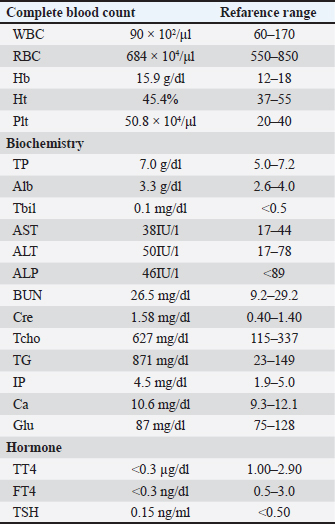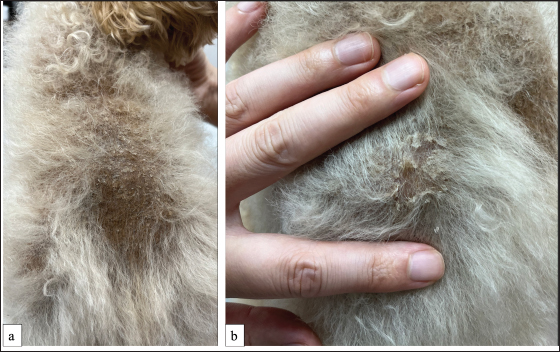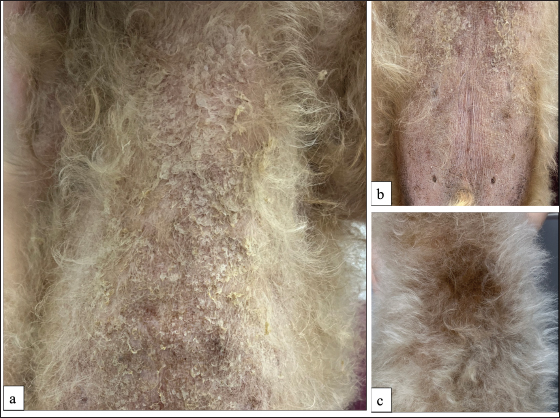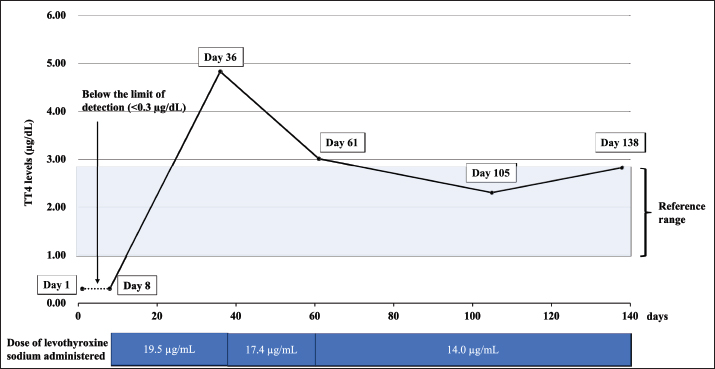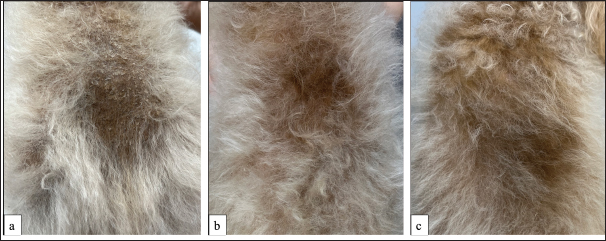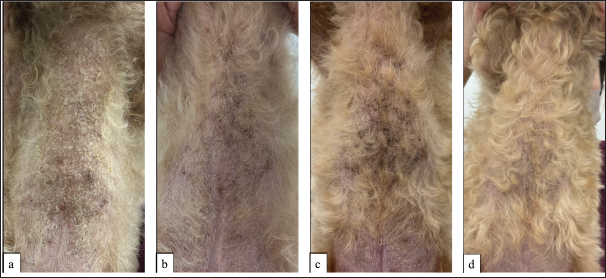
| Case Report | ||
Open Vet J. 2024; 14(10): 2707-2713 Open Veterinary Journal, (2024), Vol. 14(10): 2707–2713 Case Report Scales in a dog after levothyroxine sodium treatment: A case reportYoichiro Kasuga1,2* and Nobuo Murayama31Animal Medical Course, Department of Medical Sports, Faculty of Health Care and Medical Sports Department, Teikyo Heisei University, Ichihara, Japan 2Myogadani Animal Hospital, Tokyo, Japan 3Dermatology Services for Dogs and Cats, Tokyo, Japan *Corresponding Author: Yoichiro Kasuga. Animal Medical Course, Department of Medical Sports, Faculty of Health Care and Medical Sports Department, Teikyo Heisei University, Ichihara, Japan. Email: y.kasuga [at] thu.ac.jp Submitted: 13/07/2024 Accepted: 10/09/2024 Published: 31/10/2024 © 2024 Open Veterinary Journal
AbstractBackground: Scales are composed of exfoliated keratinocytes and are frequently a secondary change, requiring the determination of the underlying cause. Consequently, making an appropriate differential diagnosis of scales and determining treatment necessity based on the results is crucial in dermatological practice. Case Description: We present a 7-year-old, neutered male Toy Poodle examined at Myogadani Animal Hospital with chief complaints of exercise intolerance, unexplained weight gain, and dermatological signs, including symmetrical alopecia of the trunk. The dog was diagnosed with hypothyroidism and administered levothyroxine sodium. A significant number of scales were observed, primarily on the trunk, after 1 month of administration. The scales disappeared after only reducing the dose of levothyroxine sodium for 3 months. Additionally, hair regrowth was observed as the scales disappeared. In this case, the scales were primarily observed in the alopecia area of the trunk, where hair growth was subsequently noted. Hence, levothyroxine sodium administration was thought to not only facilitate hair regrowth but also influence skin turnover, causing the appearance of scales. Conclusion: Clinicians who treat hypothyroidism need to be cognizant that symmetrical scales, primarily located on the trunk, do not co-occur with other skin lesions, such as erythema, and are not itchy, may appear within a month. The scales will naturally disappear in such cases when hair growth is complete; thus, no additional treatment is required. Keywords: Canine hypothyroidism, Levothyroxine sodium, Scale. IntroductionScales are composed of exfoliated keratinocytes. They are classified as secondary lesions; thus, identifying the primary cause of the lesions is necessary (Miller et al., 2012; Shimizu, 2017). The differential diagnosis for the primary disease will include parasitic infections, allergies, inflammatory diseases, and neurogenic and neoplastic disorders if the animal is pruritic. The differential diagnosis for underlying primary diseases includes endocrinopathies, infections, nutritional deficiencies or imbalances, metabolic diseases, and cutaneous neoplasia in the absence of pruritus (Miller et al., 2012). Hypothyroidism is most predominantly an acquired condition of adult dogs, characterized by primary thyroid gland failure to produce adequate thyroxine (T4) and triiodothyronine (T3) levels (Bugbee et al., 2023). The pathogenesis of hypothyroidism prevalently involves immune-mediated functional thyroid tissue (thyroiditis) destruction or idiopathic thyroid atrophy, which may represent end-stage thyroiditis (Gosselin et al., 1981; Bugbee et al., 2023). Dermatologic abnormalities frequently occur and often include truncal nonpruritic alopecia, “rat tail” appearance, poor coat quality, seborrhea, hyperpigmentation, and recurrent pyoderma (Dixon et al., 1999). Other predominantly reported clinical signs include lethargy, mental dullness, exercise intolerance, obesity or unexplained weight gain, and heat-seeking behaviors; whereas facial nerve paralysis, vestibular disease, and polyneuropathy are less commonly reported associations (Vitale and Olby, 2007). Initial biochemical screening abnormalities are nonspecific, with fasted hypercholesterolemia, hypertriglyceridemia, and mild nonregenerative anemia most predominantly observed (Corsini et al., 2021). Canine hypothyroidism treatment involves sodium levothyroxine administration (Strey et al., 2021; Bugbee et al., 2023). However, to the best of the authors’ knowledge, no studies report cases of scaling during the treatment process. A case involved a hypothyroid dog receiving levothyroxine sodium. The dog demonstrated a notable number of scales, primarily on the trunk after 1 month. No additional treatment was administered, except for tapering down levothyroxine sodium. The scales had disappeared after 3 months, and hair growth was observed simultaneously. Reporting on this case is crucial because it indicated an association between scales and levothyroxine sodium administration. Case DetailsWe report a 7-year-old, neutered male Toy Poodle examined at Myogadani Animal Hospital on August 1, 2023, (Day 1) with chief complaints of exercise intolerance, unexplained weight gain, and dermatological signs, including symmetrical alopecia of the trunk. On physical examination, the dog weighed 6.40 kg and had a body condition score of 6/9, a muscle condition score (MSC) that indicated normal muscle mass, and no major abnormalities on auscultation. Blood tests during fasting revealed no significant abnormalities in the complete blood count (Table 1). However, biochemical analysis revealed elevated cholesterol and triglyceride levels (Table 1). Thyroid hormones were measured, revealing a total thyroxine (TT4) level of <0.30 µg/dl (reference range: 1.00–2.90 µg/dl), free thyroxine (FT4) of <0.3 ng/dl (reference range: 0.5–3.0 ng/dl), and thyroid-stimulating hormone (TSH) of 0.15 ng/ml (reference range: <0.50 ng). All three thyroid hormones were determined via the chemiluminescence enzyme immunoassay method. The dog was diagnosed with hypothyroidism based on these results. Levothyroxine sodium (Thyradin-S Tablets, Asuka Pharmaceutical Co., Ltd., Tokyo) at 19.5 µg/kg twice daily was initiated. Subsequently, T4 was 4.83 µg/dl on September 5, 2023 (Day 36), indicating that levothyroxine sodium dosage should be reduced to 17.4 µg/kg. All blood samples were collected for follow-up testing of TT4 within 4–6 hours after levothyroxine administration. Table 1. Laboratory findings on Day 1.
However, on September 15 (Day 46), the patient visited our hospital with a chief complaint of scales on the dorsal thoracic region. The scales had been present for approximately 1 week and the area was slightly itchy. The dog weighed 5.65 kg (BSC: 5/9 and MSC: normal muscle mass), with a temperature of 38.5°C and a heart rate of 150 bpm. The physical examination findings indicated no other significant abnormalities, and the dog exhibited no problems with activity or appetite. Alopecia was observed on the dorsal skin of the dog’s thorax, and the area was pigmented and covered with scales (Fig. 1a). The owner reported that alopecia had been present for some time. Additionally, scales were found on the dorsal surface of the trunk, in areas other than the alopecia, when brushing away the hair (Fig. 1b). The case demonstrated increased activity and weight loss after levothyroxine sodium treatment. A dermatological examination, including a hair examination (trichography), cytological examination (impression smears), and Wood’s lamp test, was conducted, revealing no significant changes. The clinical signs and dermatological test results indicated endocrine abnormalities, nutritional deficiencies or imbalances, and metabolic diseases as potential differential diagnoses for the sudden appearance of scales. However, we hypothesized a causal association between levothyroxine sodium administration and the scales, considering that the patient received levothyroxine sodium before the onset of scales. The patient demonstrated some mild itching, but we decided to continue monitoring their condition as we proceeded with tapering down the levothyroxine sodium dosage. Numerous scales were observed on the ventral side of the trunk at the follow-up examination on September 30 (Day 61), which had not been seen at the previous examination (Fig. 2a and 2b). However, hair growth was found in the alopecia area on the dorsal side of the chest, and the scales had disappeared (Fig. 2c). Simultaneously, the TT4 level was 3.01 µg/dl. These results indicate the benefits of reducing levothyroxine sodium dose to 14.0 µg/kg. The ventral trunk scales demonstrated a notable reduction, with only a few fine scales remaining, on October 14 (Day 75). Hair growth had been completed on the dorsal side of the thorax, but the color of the newly grown hair was darker than the surrounding area. The scales on the ventral side of the trunk had almost completely disappeared on November 13 (Day 105). Pigmentation had increased compared to the previous examination, whereas hair growth had occurred. TT4 was 2.30 µg/dl, indicating that the same levothyroxine sodium dose should be continued. The pigmentation on the ventral side of the trunk had diminished on December 16 (Day 138), with nearly complete hair growth. TT4 level was 2.82 µg/dl, indicating that the same dose should be continued.
Fig. 1. Clinical presentation on Day 46 when the first dermatological symptoms appeared. Scales observed in the dorsal aspect of the thorax (a). Scales observed in the hairy region (b). Figure 3 shows changes in TT4 levels and levothyroxine sodium doses administered from the initial visit. Figures 4 and 5 show hair growth progression on the dorsal and ventral aspects of the trunk, respectively. DiscussionWe reported a case of a dog with hypothyroidism who developed a scale after levothyroxine sodium administration. Hypothyroidism is often overdiagnosed because of non-specific symptoms and problems in interpreting thyroid function tests (Bugbee et al., 2023; Travail et al. 2024). For example, a secondary decrease in TT4 levels has been reported to occur during periods of illness or stress; in certain breeds, such as sighthounds (greyhounds or Salukis); with age; and with administration of certain medications, such as prednisone (Daminet and Ferguson 2003; Diaz Espineira et al., 2007; Shiel et al., 2010; Krogh et al. 2014; Hegstad-Davies et al., 2015; Corsini et al. 2024). This patient presented with clinical symptoms of exercise intolerance and unexplained weight gain; skin manifestations, such as symmetrical hair loss on the trunk; biochemical tests showing fasting hypercholesterolemia and hypertriglyceridemia; and thyroid function tests showing low TT4 and FT4 levels, which suggested typical hypothyroidism (Dixon and Mooney 1999; Boretti and Reusch 2004; Bugbee et al., 2023). In addition, the patient was diagnosed with hypothyroidism based on the rapid improvement of exercise intolerance and weight gain after levothyroxine administration (Bugbee et al., 2023). Scales comprise exfoliated keratinocytes and are frequently a secondary change that requires the determination of the underlying cause (Miller et al., 2012; Shimizu, 2017). In this case, the scales were observed 1 month after levothyroxine sodium administration for canine hypothyroidism. No additional treatment was administered, except for tapering down levothyroxine sodium. The scales had disappeared after 3 months, and hair growth was observed in the same area simultaneously. Therefore, an association with the drug was strongly suspected. The potential effects of levothyroxine sodium on the skin were considered, including iatrogenic hyperthyroidism, levothyroxine sodium side effects, and skin turnover resumption during the healing process of hypothyroidism. Hyperthyroidism in dogs is similar to that in cats, concerning iatrogenic hyperthyroidism. Various symptoms have been reported in dogs with hyperthyroidism, including excitement, diarrhea, high body temperature, tachycardia, tachypnea, tremors, and weight loss (Fine et al., 2010; Tolbert and Ward, 2010; Potter et al., 2020; Merkle et al., 2021). However, no reports described scaling. Similarly, anorexia, itching, and skin symptoms, including erythema, decreased activity, vomiting, diarrhea, polyuria, and hyperactivity have been reported as levothyroxine sodium side effects (Budde and McCluskey, 2018), but with no cases of scaling.
Fig. 2. Clinical presentation on Day 61 (15 days after Fig. 1). Large scales observed on the ventral aspect of the thorax (a) and fine scales seen ventral aspect of the abdomen (b). Hair regrowth observed in the dorsal alopecia region (c). New coat that was darker brown than the original coat (c).
Fig. 3. Trend in TT4 levels and levothyroxine sodium dosage. Although levothyroxine sodium improved the patient’s clinical symptoms, the dosage was gradually reduced because the TT4 level markedly increased beyond the reference range (Day 36). After decreasing the levothyroxine sodium dosage, the TT4 level decreased to within the reference range without exacerbation of clinical symptoms (days 105 and 138).
Fig. 4. Coat changes in the dorsal alopecia region observed on days 46 (a), 61 (b), and 75 (c). Scales in the alopecia region that were first seen disappeared and a new coat was grown after 15 days.
Fig. 5. Coat changes in the ventral alopecia region observed on days 61 (a), 75 (b), 105 (c), and 138 (d). Scales gradually disappeared, and hair growth was seen gradually instead. Pigmentation gradually increased by Day 105 (c) but then decreased (d). Conversely, four reasons support the hypothesis that the resumption of skin turnover during the healing process of hypothyroidism causes the scales. First is the location of the appearance of scales. In this case, scales were observed in the trunk, particularly in the alopecia area. The pathophysiology of hypothyroidism-induced alopecia is characterized by hair cycle arrest, which is not seen throughout the body but is more pronounced in specific body areas, such as the trunk and tail (Miller et al., 2012; Jackson et al., 2021; Bugbee et al., 2023). In particular, the areas of the skin in which metabolism slows down due to hypothyroidism are not uniform. Hypothesizing that sodium levothyroxine administration improves cell metabolism (Miller et al., 2012; Budde and McCluskey, 2018), thereby promoting hair growth cycle resumption and skin turnover. Levothyroxine sodium administration is postulated to facilitate hair cycle resumption and skin turnover by improving cell metabolism. Additionally, alterations in cellular metabolism due to hormones caused the scale formation (Miller et al., 2012; Shimizu, 2017). Therefore, the areas where the scales were observed and hair loss occurred were generally the same, supporting the hypothesis that this is caused by skin metabolism changes due to levothyroxine sodium (Miller et al., 2012 and McCluskey, 2018). Second, several scales were observed after levothyroxine sodium administration, but with no additional scales. This indicates that the scales are a transient phenomenon associated with skin turnover restoration to a state of normality. Third is the timing of the scales’ appearance. A dog’s viable epidermis (basal to granular layer) is turned over in approximately 22 days (Baker et al., 1973 and Miller et al., 2012). In this case, the scales were observed approximately 1 month after levothyroxine sodium administration, which is consistent with the hypothesis that they are caused by skin turnover resumption. Fourth, the scales were observed not around hair follicles but throughout the epidermis. This indicates that the scales are associated with skin turnover rather than with hair growth. Therefore, the process of skin turnover had also ceased in the regions where alopecia was observed, in a manner analogous to hair cycle cessation caused by the effects of hypothyroidism. Levothyroxine sodium administration was hypothesized to facilitate both hair cycle and skin turnover resumption. Furthermore, transient scales may be observed in conjunction with the onset of skin turnover. Additionally, not all hypothyroidism cases demonstrated the same amount of scales as in this case during the recovery process; hence, different circumstances may exist in this case. In this case, TT4 levels were rapidly elevated from below the measurement limit to exceeding the standard value in a relatively short period after levothyroxine sodium administration. This discrepancy between the case in question and other similar cases may be the underlying cause of the significant number of scales observed. Pathologically, scales are classified into retention and proliferation hyperkeratosis. Retention hyperkeratosis is when excessive cohesion of the stratum corneum disables normal shedding, and bulk shedding after accumulating to a certain extent, whereas proliferation hyperkeratosis is a condition in which keratinocyte proliferation is accelerated (Miller et al., 2012; Shimizu, 2017; Jackson et al., 2021). Pathological findings are crucial for understanding the mechanisms behind the appearance of scales, whereas in this case, a skin biopsy could not be performed due to the owner’s lack of consent. Therefore, investigating the detailed mechanism further in this case was impossible. Scales that precede hair growth are frequently experienced in dermatological practice. However, no reports describe the course of this condition. These scales will be transient and will naturally remit without requiring any specific treatment. The characteristics of these transient scales are that they appear within a month of levothyroxine sodium administration, are symmetrical, mainly on the trunk, do not accompany other skin lesions such as erythema, and are not itchy. Therefore, this study is significant because it makes this pattern of scales more predominantly known. The authors hypothesize that the appearance of the scales is indicative of a restart in the skin’s turnover cycle, caused by an accelerated skin metabolism due to levothyroxine sodium administration. However, accumulating more cases in the future and performing further analysis using pathological examinations are warranted. ConclusionScales are generally classified as secondary lesions, and investigating the cause and treating it accordingly is necessary. However, when treating hypothyroidism, one should consider that scales that do not require any special treatment may appear. As in the current case study, scales were observed before hair growth, which is expected to disappear naturally before and after hair growth completion. AcknowledgmentsNone. Conflict of interestThe authors declare that there is no conflict of interest. FundingThis research received no specific grant. Authors’ contributionsYK and NM wrote the manuscript. YK carried out the clinical evaluation and clinical care. All authors contributed to the final version of the manuscript. Data availabilityAll data pertaining to the study findings are available within the manuscript. ReferencesBaker, B.B., Maibach, H.I., Park, R.D., McFarland, L.Z. and O’Brien, T.R. 1973. Epidermal cell renewal in the dog. Am. J. Vet. Res. 34, 93–94. Boretti, F.S. and Reusch, C.E. 2004. Endogenous TSH in the diagnosis of hypothyroidism in dogs. Schweiz. Arch. Tierheilkd. 146, 183–8. Budde, J.A. and McCluskey, D.M. 2018. Plumb’s veterinary drug handbook. 10th ed. Hoboken, NJ, USA: Wiley-Blackwell. Bugbee, A., Rucinsky, R., Cazabon, S., Kvitko-White, H., Lathan,, P., Nichelason A. and Rudolph, L. 2023. 2023 AAHA selected endocrinopathies of dogs and cats guidelines. J. Am. Anim. Hosp. Assoc. 59, 113–135. Corsini, A., Del Baldo F., Lunetta, F., Ribichini, S., Giunti, M., Fidanzio, F. and Fracassi, F. 2024. Total thyroxine, triiodothyronine, and thyrotropin concentrations during acute nonthyroidal illness and recovery in dogs. J. Vet. Intern. Med. 38, 1345–52. Corsini, A., Faroni, E., Lunetta, F. and Fracassi, F. 2021. Recombinant human thyrotropin stimulation test in 114 dogs with suspected hypothyroidism: a cross-sectional study. J. Small Anim. Pract. 62, 257–264. Daminet, S. and Ferguson, D.C. 2003. Influence of drugs on thyroid function in dogs. J. Vet. Intern. Med. 17, 463–72. Diaz Espineira, M.M., Mol, J.A., Peeters, M.E., Pollak, Y.W.E.A., Iversen, L., van Dijk, J.E., Rijnberk, A. and Kooistra, H.S. 2007. Assessment of thyroid function in dogs with low plasma thyroxine concentration. J. Vet. Intern. Med. 21, 25–32. Dixon, R.M., and Mooney, C.T. 1999. Evaluation of serum free thyroxine and thyrotropin concentrations in the diagnosis of canine hypothyroidism. J. Small Anim. Pract. 40, 72–8. Dixon, R.M., Reid, S.W. and Mooney, C.T. 1999. Epidemiological, clinical, haematological and biochemical characteristics of canine hypothyroidism. Vet. Rec. 145, 481–487. Fine, D.M., Tobias, A.H. and Bonagura, J.D. 2010. Cardiovascular manifestations of iatrogenic hyperthyroidism in two dogs. J. Vet. Cardiol. 12, 141–146. Gosselin, S.J., Capen, C.C. and Martin, S.L. 1981. Histologic and ultrastructural evaluation of thyroid lesions associated with hypothyroidism in dogs. Vet. Pathol. 18, 299–309. Hegstad-Davies, R.L., Torres, S.M., Sharkey, L.C., Gresch, S.C., Muñoz-Zanzi, C.A. and Davies, P.R. 2015. Breed-specific reference intervals for assessing thyroid function in seven dog breeds. J. Vet. Diagn. Invest. 27, 716–27. Krogh, A.K., Legind, P., Kjelgaard-Hansen, M., Bochsen, L. and Kristensen, A.T. 2014. Exercise induced hypercoagulability, increased von Willebrand factor and decreased thyroid hormone concentrations in sled dogs. Acta. Vet. Scand. 56, 11. Jackson, H. and Marsella, R. 2021. BSAVA manual of canine and feline dermatology, 4th ed. Quedgeley, UK: BSAVA. Merkle, J.E., Boudreaux B., Langohr, I., Hegler, A., Ryan, K. and Fletcher, J. 2021. Thyroid storm in a dog secondary to thyroid carcinoma. J. Vet. Emerg. Crit. Care. (San Antonio) 31, 428–431. Miller W.H., Griffin C.E. and Campbell K.L. 2012. Muller & Kirk’s small animal dermatology. 7th ed. Philadelphia, PA, USA: W. B. Saunders. Potter, J.J., Cook, J. and Meakin, L.B. 2020. Suspected thyroid storm in a cat anaesthetised for bilateral thyroidectomy. Vet. Rec. Case Rep. 8, e000895. Shiel, R.E., Sist, M,. Nachreiner, R.F., Ehrlich, C.P. and Mooney, C.T. 2010. Assessment of criteria used by veterinary practitioners to diagnose hypothyroidism in sighthounds and investigation of serum thyroid hormone concentrations in healthy Salukis. J. Am. Vet. Med. Assoc. 236, 302–8. Shimizu, H. 2017. Shimizu’s dermatology. Hoboken, NJ, USA: Wiley-Blackwell. Strey, S., Mischke,, R. and Rieder J. 2021. Hypothyroidism in dogs: an overview. Tierarztl Prax. Ausg. K Kleintiere Heimtiere 49, 195–205. Tolbert, M.K. and Ward, C.R. 2010. Feline thyroid storm: rapid recognition to improve patient survival. Compend. Contin. Educ. Vet. 32, E2. Travail, V., Fernandez Sanchez, C., Costo, J.M., Valentine, N., Conroy, M., Lee, V., Bouziopoulos, D., Bateman, K., Gatehouse, E., Cruzado-Perez, J., Pollard, D., Lamb V., Juvet, F., and Kelly, D. 2024. Assessment of the likelihood of hypothyroidism in dogs diagnosed with and treated for hypothyroidism at primary care practices: 102 cases (2016–2021). J. Vet. Intern. Med. 38, 931–41. Vitale, C.L. and Olby, N.J. 2007. Neurologic dysfunction in hypothyroid, hyperlipidemic Labrador Retrievers. J. Vet. Intern. Med. 21, 1316–1322. | ||
| How to Cite this Article |
| Pubmed Style Kasuga Y, Murayama N. Scales in a dog after levothyroxine sodium treatment: A case report. Open Vet J. 2024; 14(10): 2707-2713. doi:10.5455/OVJ.2024.v14.i10.21 Web Style Kasuga Y, Murayama N. Scales in a dog after levothyroxine sodium treatment: A case report. https://www.openveterinaryjournal.com/?mno=205641 [Access: July 09, 2025]. doi:10.5455/OVJ.2024.v14.i10.21 AMA (American Medical Association) Style Kasuga Y, Murayama N. Scales in a dog after levothyroxine sodium treatment: A case report. Open Vet J. 2024; 14(10): 2707-2713. doi:10.5455/OVJ.2024.v14.i10.21 Vancouver/ICMJE Style Kasuga Y, Murayama N. Scales in a dog after levothyroxine sodium treatment: A case report. Open Vet J. (2024), [cited July 09, 2025]; 14(10): 2707-2713. doi:10.5455/OVJ.2024.v14.i10.21 Harvard Style Kasuga, Y. & Murayama, . N. (2024) Scales in a dog after levothyroxine sodium treatment: A case report. Open Vet J, 14 (10), 2707-2713. doi:10.5455/OVJ.2024.v14.i10.21 Turabian Style Kasuga, Yoichiro, and Nobuo Murayama. 2024. Scales in a dog after levothyroxine sodium treatment: A case report. Open Veterinary Journal, 14 (10), 2707-2713. doi:10.5455/OVJ.2024.v14.i10.21 Chicago Style Kasuga, Yoichiro, and Nobuo Murayama. "Scales in a dog after levothyroxine sodium treatment: A case report." Open Veterinary Journal 14 (2024), 2707-2713. doi:10.5455/OVJ.2024.v14.i10.21 MLA (The Modern Language Association) Style Kasuga, Yoichiro, and Nobuo Murayama. "Scales in a dog after levothyroxine sodium treatment: A case report." Open Veterinary Journal 14.10 (2024), 2707-2713. Print. doi:10.5455/OVJ.2024.v14.i10.21 APA (American Psychological Association) Style Kasuga, Y. & Murayama, . N. (2024) Scales in a dog after levothyroxine sodium treatment: A case report. Open Veterinary Journal, 14 (10), 2707-2713. doi:10.5455/OVJ.2024.v14.i10.21 |





